 |
 |
Parrots are frequently called 'nature's athletes' and many of them travel for miles every day to forage for food. Their entire body is set up for flight, from their hollow bones, to the extremely good respiratory system.
Even the weaning process revolves around flight, baby birds dropping weight just before fledging so that their first flights don't tax virgin muscles.
In captivity, particularly in the United States and Canada, most hand-raised parrots are clipped before fledging, before they have the ability to practice flying, to learn what their bodies are capable of, to fully understand moving through space. To learn the art of turning, of avoiding obsticles, of landing.
A baby bird without this knowledge can grow up to be an adult who is clumsy, who does not play hard for fear of falling, who may bite because they do not believe that they can get away, who is not confident in themselves.
If you search on the internet and in books, you will find as many opinions for clipping wings as you will find against, and almost everyone is religious about their opinion.
Far too many things in the world are presented as black and white. When animals are involved, it tends to be even worse, with people violently defending their viewpoint. I believe that with parrots, along with life in general, the right answers tend to be in the shades of grey.
And so I offer my opinions on one of those usual black and white subjects -- clipping a parrot's wings. Interestingly enough, clipping parrot's wings by default is a habit that is mostly North American (and possibly Australian). In Europe, most parrots are left flighted.
Why clipping?The reasons that people generally give to clip the parrot's wings are loss prevention, safety, training, and behavior. Some of these are very important reasons, others are often invalid.
Let's start with loss prevention. For those people who do not have control over their windows and doors (particularly those with children who have a tendency to not shut things behind them), a flighted parrot is at extreme risk of flying out an open door or window. For this reason alone, clipping wings is important in a lot of environments.
However, the other side to this coin is that clipping wings does not prevent most parrots from flying outside. My sun conure, a small, light bodied bird, can fly expertly with only one grown in primary on each wing. With two, he's a demon in the air. Even with a proper wing clip (more on this later), a breeze outside would have him flying away. A spooked parrot can more than make up for their lack of primaries with adrenaline. It is not safe to take any small parrot outside, regardless of how serious their clip is. The same thing goes for a lot of larger parrots, particularly those who are good fliers. I do believe that all parrots need some time outside, and the safest ways to do so is either with an outdoor flight, a smaller outdoor cage, or a secure harness or leash.
One of the most common situations where parrots are lost are when a person of a light bodied parrot takes that parrot outside unrestrained. Flighted parrots change the situation because they remind you daily that they can fly... and so most people will take that into consideration when leaving the house. Clipped parrots don't, and it's a huge shock when a breeze gives them enough lift to go.
The second common statement is safety. Unclipped parrots can panic and fly into things and hurt themselves. This is absolutely a true statement. However, clipped parrots can do the same if they're frightened enough. And a clipped parrot who has never flown has no idea how to manage themselves in the air. A parrot who knows how to fly does. There are a lot of things that are dangerous to parrots in the house, particularly mirrors and windows, as they don't immediately understand that they are solid. But a parrot who knows how to fly and who panics tends to fly to a safe place, not into things. Flight is their #1 defense against predators, and I am positive that in the wild, panicked parrots fly around a lot without crashing into trees.
Training is another reason to clip wings. It is completely accurate that a parrot who is flighted will not stay where you put him if he does not want to. And a flighted parrot who is not tame or not used to you is dangerous to have around simply because you have no control whatsoever on them. I have clipped every parrot that came into the house at first to allow them to get used to me, me to get used to them, and everyone to interact without the additional worries of flying around.
The last common reason given is behavior. There is an ongoing belief that parrots who can fly are "aggressive, "dominant", tend to bite harder and more, and refuse to obey their owners. I find this idea to be both untrue and a little bit ridiculous. The only difference between a flighted parrot and a clipped parrot is that the flighted parrot can choose to go elsewhere, and a clipped parrot cannot. Having a flighted parrot makes it clear exactly how much good aggressive and domineering behaviors are in dealing with parrots -- no good at all. Our job as parrot caretakers is to work with our parrots, not against them. A person who appropriately teaches their parrot that people are good things, that flying to specific places on cue is a lot of fun, and that going in their cage means good treats should have no issues with a flighted parrot. If we work to have our parrots want to do what we want them to do, everyone benefits. Forcing or bossing around the parrot to get what you want doesn't help anyone and can damage your relationship with a parrot.
Time for an example. I own an adult sun conure who is bonded to me. He is flighted and an expert flier. He will step up for me from any place in the house, including from a perch near the ceiling (some four or so feet higher than my head), out of his cage, and even from the top of my head. He will also step up for the rest of the household from all the same places, though he may protest a little more. His behavior flighted and clipped is exactly the same, with the small exception that clipped, he doesn't fly off his playstand as often.
There's another side to behavior though. Some parrots, whether by previous owners, bad experiences, or hormonal rushes, are more prone to bite than others. It's dangerous to have a parrot who loves biting people and who can fly, dangerous to both the person and the parrot (being swatted aside could be fatal). A clipped parrot who bites still has a problem that needs to be worked on, but it is reasonable to compromise with a parrot who has problems, and clip their wings while working on the problems. Flight may or may not be possible, but clipping wings is much, much better than plastic surgery.
In summary, I believe that training and loss prevention are very good reasons to clip parrot's wings, and that it is far safer to have a parrot who has learned how to fly (even if clipped!) in the house.
A proper wing clip can be any number of feathers clipped, so long as two rules are followed. First, the parrot must be able to fly at least 10 ft, without gaining height, and land comfortably. Second, none of the secondaries should be clipped, and it is highly preferably not to leave the two first feathers at full length. For some parrots, leaving the first two primaries (because it looks better) is enough for them to fly far better than a clipped bird should be able to.
Some people choose to cut the feather roughly in half, others choose to clip the feather at the base to not leave rough ends that may bother the bird. Either way works, and the number of feathers to clip is dependent on the parrot. Stronger fliers need more feathers clipped, as do lighter birds. Heavy birds who are not strong fliers need fewer. A proper clip for a parrot has them able to glide at approximately a 45 degree angle to the floor. More than that, and they're at risk for injuring themselves when falling.
Why flight?There are a number of reasons to keep a parrot flighted. The most commonly listed ones are exercise, confidence, and happiness of the parrot.
Exercise is absolutely a true reason. Most people would agree that parrots were designed to fly, and that the intense aerobic workout of flight does wonders for their health. Too many parrots are extremely out of shape, and if people wish to clip their wings, they should do some research into alternative methods of exercise, such as encouraging flapping, climbing, or walking.
Confidence. I am lucky, right now, to have the greatest two parrots to compare and contrast. One of them is a two year old African grey who has been flying for about nine months. The other is a one year old double yellow head Amazon who has been clipped her entire life. Cin, the grey, will step up onto any perch, no matter how unstable or strange. He leaps up onto the boing hanging from the ceiling, and hangs off the side of our hanging net, flapping wildly. He will hang upside down by a single toe inside and outside of his cage. He is fully aware that should he fall, he can right himself and land without injury. Ky, the Amazon, is extremely hesitant with her stepping up. She carefully tests every perch to see if it is stable enough, and if it is not, she refuses to stand on it. She holds onto your arm for dear life whenever she's moved, and when she can be convinced to go onto the boing, carefully makes her way to another stand, holding on the entire time. She knows that falls are painful and she cannot recover from them, so she tries very hard to make sure she doesn't fall. She's up to three grown in primaries on each side, so that should be changing soon enough.
Update 03/2007: Ky's been flying for some time, and as expected, has become dramatically more acrobatic.
Happiness. A lot of people say 'it is natural for parrots to fly'. This is obviously a true statement, but we do a lot of things that aren't natural. I do believe that most parrots enjoy flying, but I don't think that parrots who are not flighted are somehow less happy than those who are. The important thing is their relationship with their people, their environment, and their health, not necessarily whether or not they have full wings.
There's one major issue with having all parrots in the universe flighted, and it's pretty simple.
Flighted parrots can be a pain in the ass.
I know that's deeply blunt, and I also know that my own parrots will forgive me for the sentiment... mostly because it's true. It is harder to own a flighted parrot for a lot of reasons.
First, you have to bird proof wherever they are flying, making sure that there's nothing obviously dangerous in any part of the room, including exposed wires in the ceiling or walls, hanging plants, and a number of other things.
Second, you have to set up a number of different places for them to perch and land. You also have to go to a much greater effort to make those places interesting for them. A clipped parrot will stay where they are in most cases. If a flighted parrot gets bored, he'll fly over and check out what you're doing, landing on some part of your body and demanding scritches, paper to shred, or whatever else his little heart desires at that moment in time. On the positive side, whenever you're sick of the parrot trying to eat your keyboard, you can just fling him towards his stand and he'll go back.
Lastly, you have to get really really really paranoid about your doors and windows. Our basement, where the parrots are and we spend most of our time, has two exits. One is up the stairs to the upstairs, one is out to the backyard. All of the windows have screens. Every single time I open a door, I verify that there are no parrots out before hand. Every time I open a parrot's cage, I check the doors first. Every single time. No exceptions. Yes, it's a pain, but it becomes habit faster than you'd think.
One of the biggest things that I've heard when wing clipping comes up is that this person's specific parrot does not know how to fly and crashes into things. Human beings seem to have an instinctive urge to walk on two legs, but anyone who has ever seen a toddler knows that it takes some practice to get it right. The same thing goes for parrots. Most breeders sadly do not allow their parrots to learn to fly at the appropriate age (around the same time as weaning). This means that adult parrots who have never flown have to make up for a lot of lost time, usually without any guidance from other parrots. The good thing about parrots who have never learned to fly before is that their breast muscles are really out of shape. Few parrots will seriously injure themselves thunking into things if they're just learning. This doesn't mean none, obviously, I'm sure it happens. In my experience, though, they don't get up enough speed to do more than scrape themselves. They will crash into things, into the ground, into walls, into you, into all sorts of things if they're trying to figure out flying, particularly if they're larger birds. Our grey crashed into walls with a sickening thunk on a regular basis for about a month. And then, one day, he learned how to turn, and he's not crashed since. He can now hover in the air, negotiate doorways and places narrower than his wingspan, and turn on a dime. But if I didn't let him crash a little bit at first, and immediately clipped his wings, he never would have learned.
The best way to get all the benefits of a parrot who is properly fledged is to buy a parrot from a breeder who properly fledges his or her birds. There are some who are starting to understand how vitally important it is to the growth and development of parrots that they learn to fly, and those are the breeders who should be encouraged.
But what about rescue parrots or parrots who come already clipped? It is possible to teach a parrot how to fly even when they did not learn at the appropriate time.
Let me state this now. Teaching an adult parrot to fly is risky. It is possible for them to injure or kill themselves. There are ways to mitigate that risk, which I'll go into in a moment, but as with anything in life, it is not risk free.
Parrots need to gradually build up muscle strength and skill while they are still partially clipped so that once they have full wings and thus the ability to get some speed going, they know what they're doing and won't crash so much. A partial wing clip keeps them slow enough that they are not as likely to hurt themselves. A fully flighted parrot who has not learned to fly is at more risk than a clipped parrot or a flighted parrot who is an expert flier.
How do you teach a parrot to fly?Simple answer -- this web page is better than anything I could write to explain the basics of recall training and refledging. Specifically, check out the Step by Step Indoor Reclal Training for Parrots pdf mid-way down that page.
"Flighted birds will spook and run into walls."
"Flighted parrots will crash through windows."
"Flighted parrots will eat your entire house."
"Flighted parrots will always be fine together."
"If a parrot flies, they will never stay on a playstand."
"Once they can fly, they'll get into everything all the time."
There's a lot of misinformation about flighted parrots, a lot of misunderstandings, and very little good information for someone who is considering letting their parrot fly or learn to fly. There's also an art to setting up a household or a room for parrots to play in without them destroying everything. It tends to all run hand in hand.
I'll start from the top.
1) Windows and mirrors.
Most parrots are completely capable of learning where the windows and mirrors are in a house and that they are not passable. The easiest way I have found to do so is to put stickers, stars, or write on the windows with dry erase marker so that there is a visual barrier there for the first while of flying. I have used all of these methods, and my birds have learned very quickly that the windows are not passable. In fact, my house has two 12 foot wide picture windows that seem like they would be asking for a bird to fly through them. Very few have ever tried.
2) Spooking.
In most cases, when any of my parrots spook, they circle around the room that they are in and land in a safe landing spot. None of them have ever spooked into walls once they've become competent fliers. As an example, I took this picture of my African grey in the upstairs office just a few minutes ago.
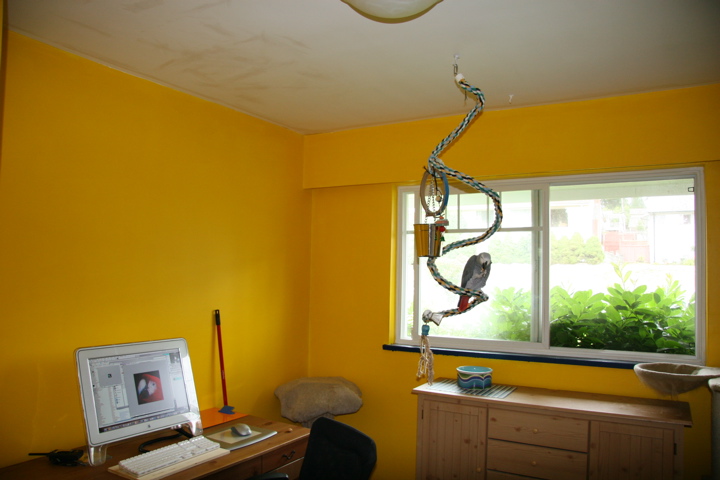
It was the first time he had been in the room, and a few minutes later, a car came past. He spooked and flew off the boing, circled the room a couple of times, and landed back where he had started. He did not crash into the walls or the window.
All of my other birds do exactly the same thing.
3) House eating, or setting yourself up for success.
It takes time to develop an eye to look at a room and determine what may be a desired landing spot. In general, the highest points in the room are a good choice. Tops of bookcases, tops of parrot cages, things of that nature. If you do not want your parrot to land there, the best thing to do is put a desired landing spot either higher or in the way.
For example, this is a narrow passage way in the upstairs of my house.
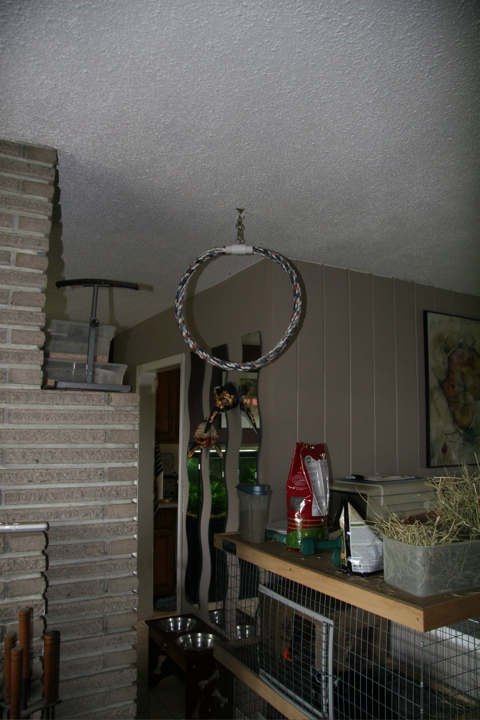
I do not want the birds to land either on the ledge next to the fireplace or on top of the (ridiculously cluttered) rabbit cage. I'm pretty sure that both of them look like pretty good choices for landing spots, so I have put a better option that is higher than the rabbit cage and partially blocks the ledge. It's a relatively boring perch right now, but tying on some toys and shredders will make it much more interesting.
Another good example:
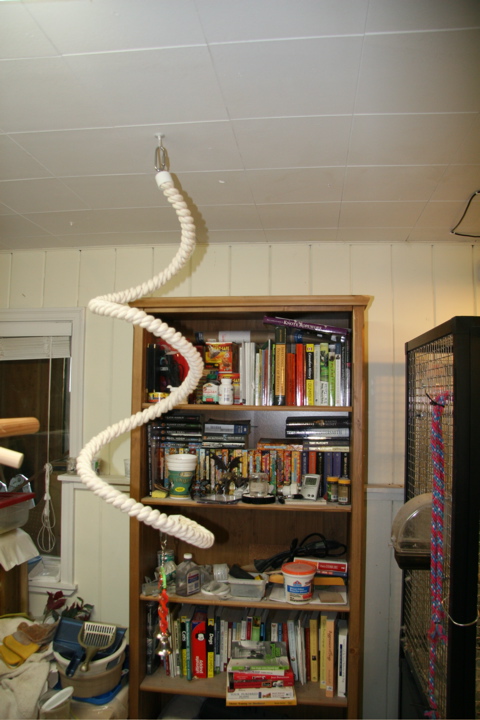
For some reason, I prefer my bookcases as I purchase them, without elegant redecorating. I also try very hard to keep parrots from flying to the top of another bird's cage, as that's asking for toe amputation. The boing there makes it more likely that the parrot will land on the boing than on the (also ridiculously cluttered) bookcase or on top of the Amazon's cage.
Speaking of cages, I know for a fact that I have two parrots who really, really, really, really would like it if more birds flew onto their cages so that they could eat them for breakfast. Yes, it's my largest and smallest parrot. :)
In the case of my macaw, Theodore, I have set up an atom almost directly in front of his cage so that in most cases, parrots don't bother to fly over. He is fine with birds on the atom near his cage, but not on his cage.
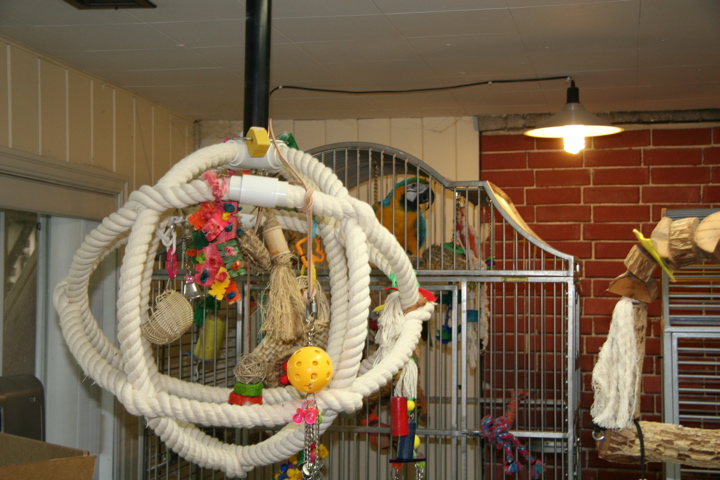
And, in the case of the lovebird, I have situated her cage in a corner, and put a net up that is higher than her cage and also partially blocks the flight path.
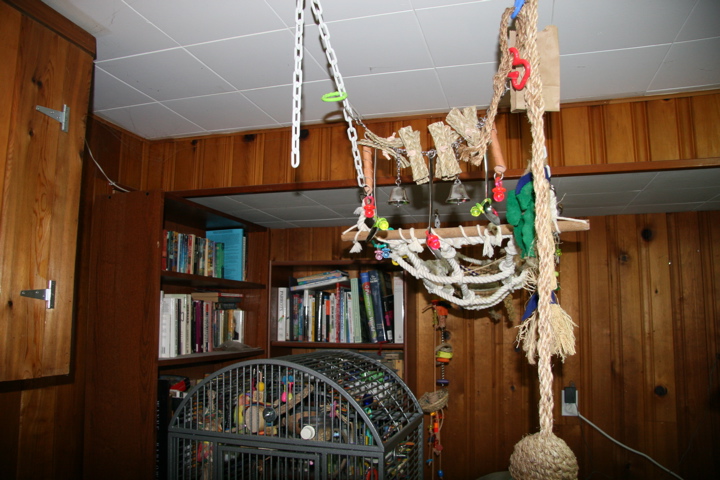
In both cases, I have almost never had a bird fly over to land on their cage.
4) Making them stay on the perch.
In general, my rule for out of cage areas is that there must be at least as many different landing areas as there are parrots that will be there, preferably at least one or two more.
This is a picture of one part of my downstairs, with my three large parrots. As you can see from this picture alone, there are four play areas/landing areas there. This room also has two others, for a total of six.
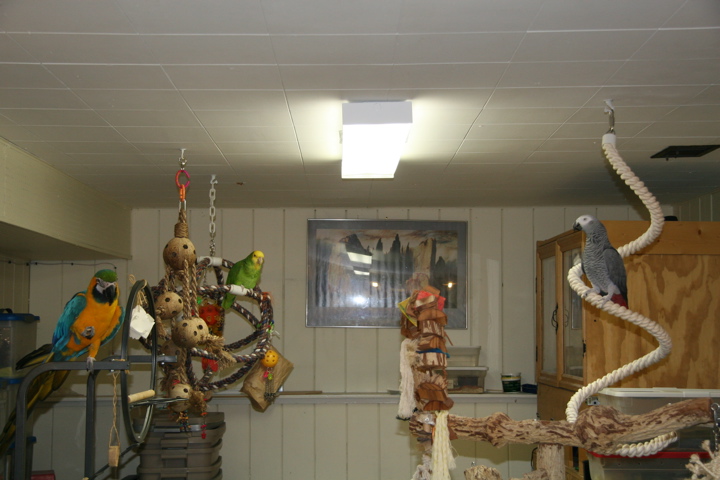
Those landing areas can be large playstands, either do it yourself:
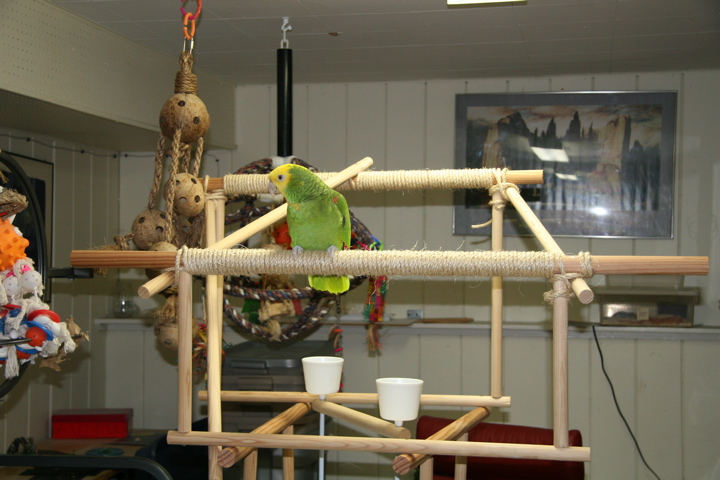
Or store bought, metal:
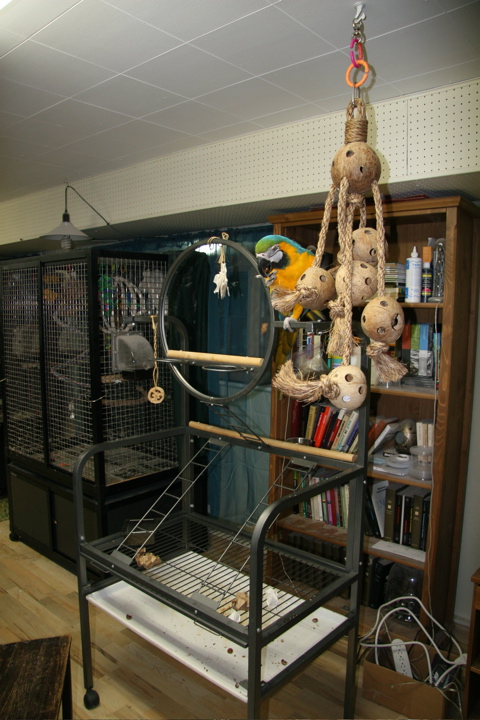
Or store bought, wood:
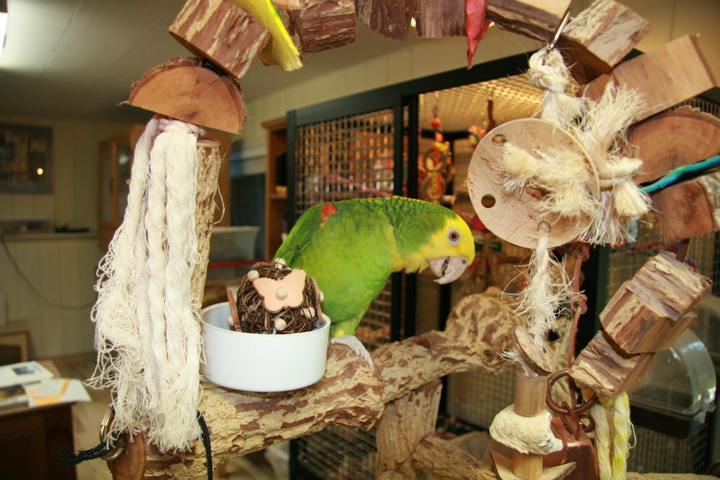
I am also very, very, very much in favor of hanging areas, such as atoms, rings, and boings, as you can see from the earlier pictures.
In general, multiple play areas with toys on them provide enough choice, enough empowerment, and enough differences that my parrots almost never choose to land somewhere else, unless it's on a preferred person.
5) Keeping them out of areas you don't want them in.
I'm a huge fan of cheap sheer curtains. A lot of other people will use beaded curtains. Parrots can fly through both sets, but they generally will not. If there's an area that your parrots absolutely must never go, you need a door to keep them out.
Here's the curtains separating my 'small bird' room from my 'big bird room' downstairs.
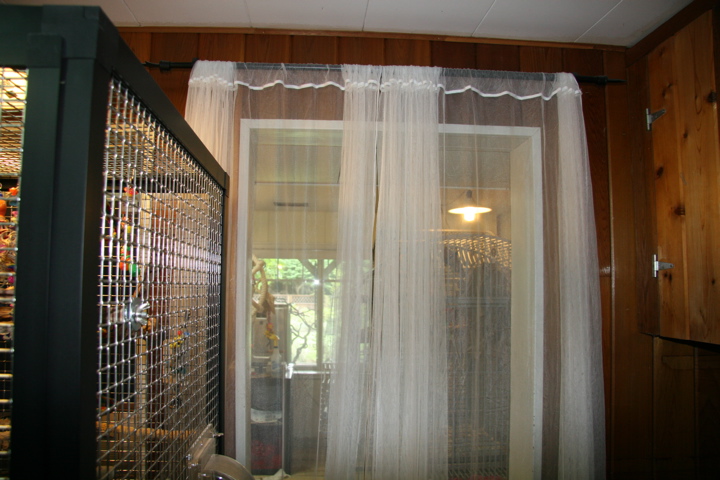
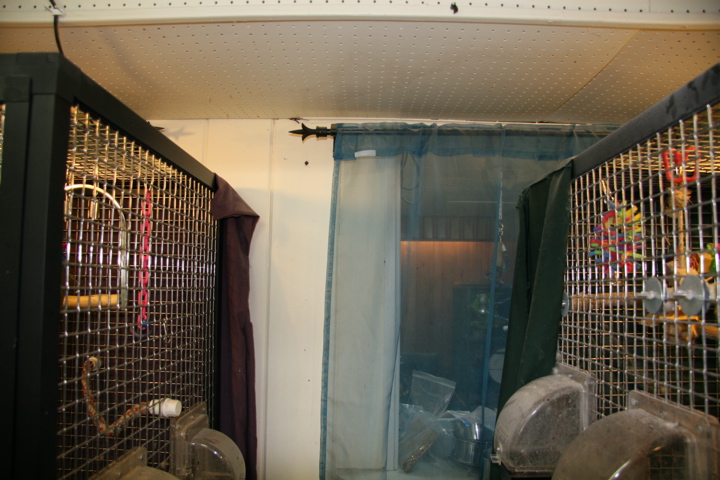
There are many other methods of parrot proofing, but these are those that have worked for me.